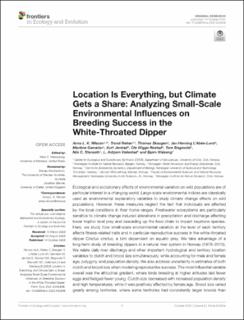| dc.contributor.author | Nilsson, Anna L.K. | |
| dc.contributor.author | Reitan, Trond | |
| dc.contributor.author | Skaugen, Thomas | |
| dc.contributor.author | L'Abee-Lund, Jan Henning | |
| dc.contributor.author | Gamelon, Marlène | |
| dc.contributor.author | Jerstad, Kurt | |
| dc.contributor.author | Røstad, Ole Wiggo | |
| dc.contributor.author | Slagsvold, Tore | |
| dc.contributor.author | Stenseth, Nils Christian | |
| dc.contributor.author | Vøllestad, L. Asbjørn | |
| dc.contributor.author | Walseng, Bjørn | |
| dc.date.accessioned | 2021-05-04T08:12:25Z | |
| dc.date.available | 2021-05-04T08:12:25Z | |
| dc.date.created | 2020-10-14T09:53:53Z | |
| dc.date.issued | 2020 | |
| dc.identifier.citation | Frontiers in Ecology and Evolution. 2020, 8 . | en_US |
| dc.identifier.issn | 2296-701X | |
| dc.identifier.uri | https://hdl.handle.net/11250/2753404 | |
| dc.description.abstract | Ecological and evolutionary effects of environmental variation on wild populations are of particular interest in a changing world. Large-scale environmental indices are classically used as environmental explanatory variables to study climate change effects on wild populations. However, these measures neglect the fact that individuals are affected by the local conditions in their home ranges. Freshwater ecosystems are particularly sensitive to climate change induced alterations in precipitation and discharge affecting lower trophic level prey and cascading up the food chain to impact keystone species. Here, we study how small-scale environmental variation at the level of each territory affects fitness-related traits and in particular reproductive success in the white-throated dipper Cinclus cinclus, a bird dependent on aquatic prey. We take advantage of a long-term study of breeding dippers in a natural river system in Norway (1978–2015). We relate daily river discharge and other important hydrological and territory location variables to clutch and brood size simultaneously, while accounting for male and female age, polygyny, and population density. We also address uncertainty in estimates of both clutch and brood size when modeling reproductive success. The most influential variable overall was the altitudinal gradient, where birds breeding at higher altitudes laid fewer eggs and fledged fewer young. Clutch size decreased with increased population density and high temperatures, while it was positively affected by female age. Brood size varied greatly among territories, where some territories had consistently larger broods than others. Increased minimum and maximum temperatures, river discharge above 10 l/s and increased variability in snow depth had a positive effect on brood size, whereas polygyny had a negative effect. In conclusion, territory-specific variables explained a large amount of the variation in the reproductive output in the dipper, emphasizing the importance of the local habitat, and not only climatic variation, in a keystone species in freshwater ecosystems. | en_US |
| dc.language.iso | eng | en_US |
| dc.rights | Navngivelse 4.0 Internasjonal | * |
| dc.rights | Navngivelse 4.0 Internasjonal | * |
| dc.rights.uri | http://creativecommons.org/licenses/by/4.0/deed.no | * |
| dc.title | Location is everything, but climate gets a share: analyzing small-scale environmental influences on breeding success in the white-throated dipper | en_US |
| dc.type | Peer reviewed | en_US |
| dc.type | Journal article | en_US |
| dc.description.version | publishedVersion | en_US |
| dc.source.pagenumber | 11 | en_US |
| dc.source.volume | 8 | en_US |
| dc.source.journal | Frontiers in Ecology and Evolution | en_US |
| dc.identifier.doi | 10.3389/fevo.2020.542846 | |
| dc.identifier.cristin | 1839399 | |
| dc.relation.project | Norges forskningsråd: 223257 | en_US |
| cristin.ispublished | true | |
| cristin.fulltext | original | |
| cristin.qualitycode | 1 | |

